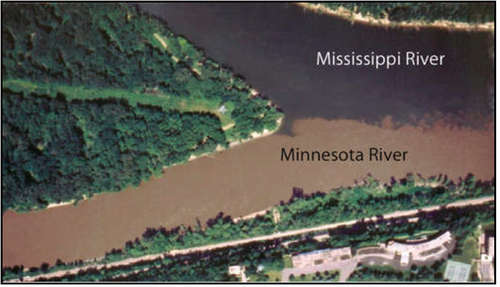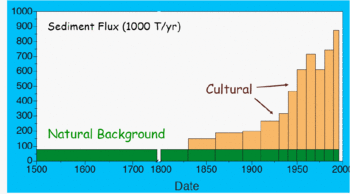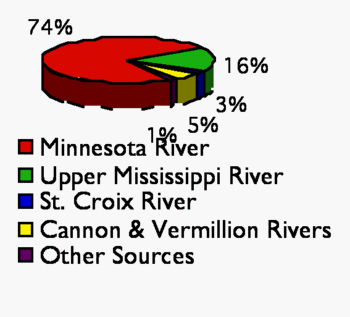Lake Pepin and the South Metro Mississippi River TMDL
Introduction
While the Mississippi River remains an iconic big river one that serves as a drinking water source, economic engine and critical ecosystem the river is also a troubled resource threatened by a variety of pollutants. One of the most pressing issues for the Mississippi River today is high turbidity suspended sediment in the water.
The South Metro section of the Mississippi River from the confluence with the Minnesota River at Fort Snelling (River Mile 844) down through the Twin Cities to Lake Pepin (River Mile 780) suffers from high turbidity (suspended sediment in the water).
This sediment impairs aquatic life and recreation throughout this reach of the river and is causing Lake Pepin a 40-square mile natural lake on the Mississippi near Lake City to fill up with sediment at 10-times its natural rate.
The Draft South Metro Mississippi River TMDL
The Clean Water Act requires that waters failing to meet state standards undergo a study called a TMDL a water clean-up plan. The TMDL clean-up plan assesses pollution sources and requires reductions that ensure clean water in the future. The South Metro Mississippi River clean-up plan is aimed at protecting the river and Lake Pepin from excess sediment that flows into the river system.
The draft clean-up plan calls for major reductions in sediment pollution to the Mississippi River from its tributaries, including the upper Mississippi River watershed and the Minnesota, St. Croix, Vermillion and Cannon Rivers. The clean up plan will also require major improvements in urban stormwater management and wastewater treatment facilities throughout the watershed.
The proposed TMDL:
- Sets a clear river restoration goal based on sound science and extensive research developed by leading state and national experts;
- Protects aquatic life and recreation opportunities in the South Metro Mississippi River, as required by the Clean Water Act;
- Ensures the continued survival of Lake Pepin;
- Can be achieved at a fair cost with already proven pollution reduction strategies;
- Is the product of broad stakeholder input from multiple agencies, interest groups and communities;
- Is the right thing to do for the Mississippi River!
- Achieves the water quality and submerged vegetation standards for the river that were established by the Minnesota Pollution Control Agency in 2010:
- Achieve about a 33% reduction in the summer average of total suspended solids in the water.
- Double the frequency of occurrence of submersed aquatic vegetation to 21 percent along the river.
Public Comment On The South Metro Mississippi River TMDL
The Minnesota Pollution Control Agency (MPCA) is preparing to take public comment on the Draft South Metro Mississippi River Turbidity TMDL. This TMDL sets clear limits on allowable level of sediment pollution and is the first step toward restoring the Mississippi River for generations to come. This is an opportunity that Minnesotans cannot afford to lose.
The proposed standard will be open for public review and comment through early May 2011. While this long overdue standard represents a great step toward protecting our Mississippi River, it is still up to the MPCA to decide whether or not to approve the standard later this spring.
What you can do
- Learn more about the South Metro Mississippi Turbidity TMDL by reading this web site and following links to other information below. A great place to start is the MPCAs South metro Mississippi River Turbidity Fact Sheet.
- Attend a public open house on the project. FMR, along with out partners at the Mississippi National River and Recreation Area (NMRRA) and the Minnesota Pollution Control Agency (MPCA) will be partnering to host an open house where you can learn more about this project and provide input:
Life Support: A Clean Up Plan For The Mississippi River Mississippi River TMDL Clean Up Plan Open House
Wednesday, May 4th 2011
3:30 - 7:30pm
Merriam Park Library
1831 Marshall Avenue
St. Paul, MN 55104 - Let your voice be heard. Comments on the proposed draft TMDL can be submitted in writing/email. While a deadline ahs not yet been set for comments, we expect the comment period to conclude by late April, 2011. Comments should be sent to MPCA staff member Norm Senjem.
By mail:Norm Senjem, MPCA
By email: norman.senjem@state.mn.us
18 Wood Lake Drive
Rochester, MN 55904
We know that submitting comment on water clean up plans can be a challenge. To assist you, we will develop a simple fact sheet and sample comments that you are welcome to review and use in developing your own comments to the MPCA. Look for those talking points here soon!
For additional information, or to learn more about FMRs role in the South Metro Turbidity TMDL, contact FMRs Watershed Program Director Trevor Russell at (651) 222-2193 ext 18 or via our contact form.
Background Information on Lake Pepin and Mississippi Sedimentation

The Minnesota Pollution Control Agency (MPCA) in the final stages of developing a turbidity clean up plan for the South Metro Mississippi River. This plan sets a clear limit on allowable level of turbidity and is the first step toward cleaning up the Mississippi River.
The Water Pollution Control Act, commonly known as the Clean Water Act (CWA) of 1972, has made important progress in cleaning up sewage treatment plants, chemical and industrial wastes, animal feedlots, and other major pollution sources.
Yet, almost 38 years after Congress demanded the protection of the chemical, biological and physical integrity of our nations waters, unregulated non-point pollution is impairing the Mississippi River from its headwaters to the Gulf of Mexico.
Mississippi River Sedimentation
The best place to witness the impacts of non-point pollution is at the confluence of the Minnesota and Mississippi Rivers near Fort Snelling in Minneapolis, Wisconsin.
Here, the relatively clear Mississippi River stands in stark contrast to the turbid (cloudy) Minnesota River, the source of the vast majority turbidity in the metro Mississippi River system.
The largely agricultural Minnesota River Basin is a prime example of how the Clean Water Act is failing to meet the needs of todays water resources. The Basins non-point sources like farm runoff, urban stormwater runoff, and other pollutants remain largely unregulated.
The Clean Water Act has helped communities make great strides in cleaning up the Mississippi River, says Whitney Clark, Friends of the Mississippi Rivers (FMR) Executive Director, but unregulated pollutants are continuing to degrade our waters. It is time for the state to address the largest sources of pollution, rather than just the ones that are the easiest to regulate.
The Minnesota River represents the largest source of sediment to the South Metro Mississippi River. - and the human impacts of agriculture and engineered drainage are the primary causes.
From the latter part of the nineteenth century through the 1950's, Minnesota law encouraged expansion of public drainage ditches in agricultural areas. Ditches, stream channel modifications and wetland losses combined to increase the volume of peak flows during spring thaws and rain events. Increased peak flows create a fire hose effect, often flushing vast quantities of sediment (soil) downstream.

Historic sedimentation rates in Lake Pepin
Image: MPCA
Crop fields are also non-point pollution sources. Heavy spring rains in unplanted fields wash topsoil into nearby waters. Row crops often require fertilizers, pesticides and herbicides that also contribute to polluted runoff. Minnesotas 20-year-old rule that requires vegetated stream buffers on agricultural land was designed to prevent much of this agricultural runoff, but it is rarely enforced. According to recent studies, at least 300,000 acres of crops are farmed in direct violation of stream buffer laws annually.
Unfortunately the Clean Water Act, for all its strengths, failed to include meaningful agricultural and rural non-point source regulation and enforcement. The consequences of non-point pollution are being felt just downstream from the St. Croix confluence, in Lake Pepin.
Lake Pepin
Lake Pepin, a natural lake on the Mississippi River, drains over 48,000 square miles (about half of the total area of Minnesota) and is home to world-class boating, fishing and other water recreation activities. Though the lake covers more than 40 square miles, at present rates of sedimentation the predicted lifespan of the upper portion of the lake is just 90 years.
The entire lake will be filled-in in roughly 300 years. The culprit: almost 1 million metric tons of upstream sediments washing into the lake each year.
Mississippi River Turbidity Standard: 2010
In 2004, Minnesota Pollution Control Agency (MPCA) monitoring results landed the South Metro Mississippi River on the states impaired waters list. Since then, Minnesota and Wisconsin, along with a wide range of stakeholders (including FMR), have joined forces to chart a course for a cleaner Mississippi River. The process, called a Total Maximum Daily Load or TMDL, is designed to identify sources of Mississippi River turbidity and assign pollution reductions accordingly. (see sidebar for more information on TMDLs)
FMR has been participating in the TMDLs Stakeholder Advisory Group and has lead the formation of a coalition of environmental groups working to ensure the state takes action to address unregulated non-point pollutants in our waters.

Sedimentation sources for Lake Pepin
Image: MPCA
The draft TMDL, due for public hearing in spring 2011, calls for 50% reductions in total suspended sediment flowing into the Mississippi River from the Minnesota and Cannon Rivers. The upper Mississippi River (above Lock & Dam #1), the St. Croix River, Vermillion River and other tributary streams will be required to meet 20% reductions. Many cities will need 25% reductions in turbidity from urban stormwater.
While these goals may seem high, there are a number of simple steps that can make drastic improvements in water quality.
Although the 50% reduction target in the Minnesota and Cannon Rivers may appear daunting to some, says Norm Senjem of the Minnesota Pollution Control Agency, we have actual monitoring evidence to show that it can be achieved with fairly modest land use changes particularly if they are focused along rivers and streams.
For the last decade, the MPCA and others have monitored the West Fork Beaver Creek, a small tributary of Hawk Creek near Renville, Minnesota. During this period, the watershed has seen a 50% reduction in suspended sediments (as well as a 25% reduction in Phosphorous). The progress was made through the targeted conversion of about 3% of the land area into perennial streambank vegetation, along with wetland restoration activity.
The vegetated stream buffers provide a protective zone between the riverbank and crop rows where plant roots help hold soils in place. Buffers also capture agricultural chemicals flowing off fields before they reach nearby waters. When combined with other practices like new drainage techniques that encourage more infiltration, ravine restoration and stream bank armoring, dramatic reductions in runoff pollution are a real possibility in rural watersheds.
Through the South Metro Mississippi River Turbidity TMDL, FMR is working to engage a broad range of agriculture, recreation, public health and water quality stakeholders to encourage similar activities throughout the Minnesota River basin.
With a little patience, sound science and targeted restoration, the days of a clean and healthy Mississippi River are once again visible on the horizon.
For More Information:
- For more information about the South Metro Mississippi River Turbidity TMDL, visit the Minnesota Pollution Control Agencys website.
- Contact FMRs Watershed Program Director - Trevor Russell by phone at: (651) 222-2193 extension 18 or by email via our contact form.
- For more information bout the Mississippi River Turbidity Site Specific Standard, visit the MPCAs web page.